Key facts
- For high-speed probing challenges
- Flexible and configurable connectivity
- Multimode function for switching between measurement modes
- Integrated high-precision voltmeter
- Integrated micro button for convenient instrument control

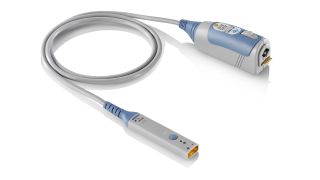
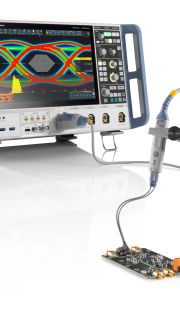
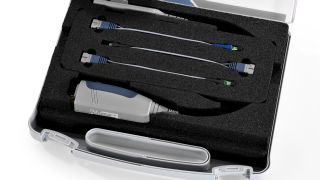
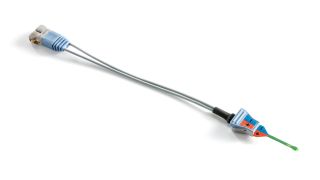
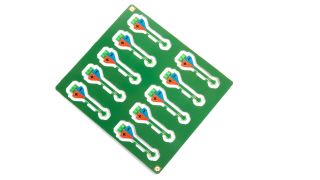

Key facts
The R&S®RT-ZM modular probe system meets current probing requirements with a technically sophisticated, yet easy-to-handle solution. The various probing solutions have high bandwidth and dynamic range along with a low capacitive load. The R&S®RT-ZM probe system includes probe tip modules for various measurement tasks and conditions. The probe tip modules can be connected to amplifier modules with bandwidths ranging from 1.5 GHz to 16 GHz.
Quick links
The R&S®RT-ZM modular probe system delivers high performance in combination with flexible and configurable connectivity. The R&S®RT-ZM probe system includes probe tip modules for various measurement tasks and conditions.
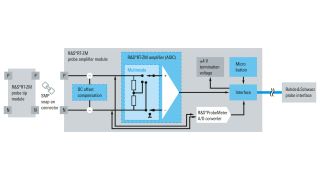
Block diagram of a modular probe system
The multimode function lets users switch between single-ended, differential and common mode measurements without reconnecting or resoldering the probe tip. The multimode function comes on the company-designed, high-speed R&S®RT-ZM amplifier ASIC.
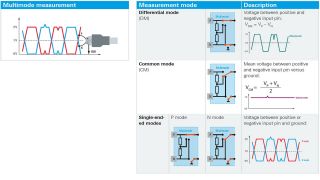
Multimode measurement of a differential signal
The R&S®RT-ZM modular probe system has a unique offset compensation range of ±16 V. The DC components of a measured signal can be compensated at the probe tip, upstream from the differential R&S®RT-ZM amplifier ASIC. The operating voltage window can be extended beyond the dynamic range of the probe amplifier module and the signal components of interest displayed on the oscilloscope with maximum resolution. The feature is also available with multimode operation.
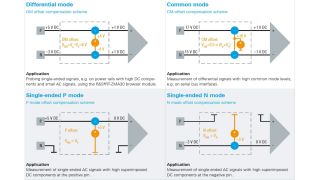
DC offset compensation for multimode measurements
The integrated and unique R&S®ProbeMeter operates independently of the oscilloscope and measures DC signal components with 0.05 % accuracy. DC measurements are continuous and in parallel with the oscilloscope waveform acquisition. Immediate digitization of the measured DC voltage with a dedicated ADC inside the R&S®RT-ZM probe amplifier module enables the high precision.
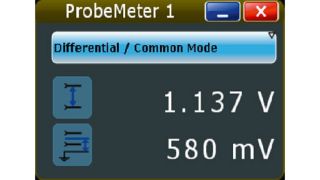
Probe meter reading
The R&S®RT-ZM probe amplifier module comes with an integrated micro button that allows users to stay focused on measurement tasks and conveniently operate oscilloscopes. The micro button can be configured on Rohde & Schwarz oscilloscopes to perform a variety of functions, such as run/stop, auto set, save waveform, find trigger level, and create automated test report. Multimode switching can also be configured for the R&S®RT-ZM modular probe system.
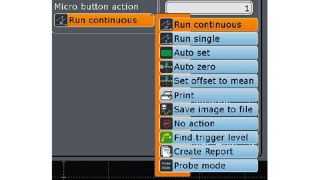
List of selectable micro button actions

Order number 1419.4301.02
Solder-in probe tip cable for R&S®RT-ZM modular probe system
> 16 GHz, < 28 ps, probe tip module, P/N/DM/CM

Order number 1801.4349.02
Set 6x solder-in probe tip cable for R&S®RT-ZM modular probe system
>16 GHz, < 28 ps, probe tip module, P/N/DM/CM

Order number 1419.4318.02
Solder-in probe tip cable with ext. temp. range for R&S®RT-ZM modular probe system
> 16 GHz, < 28 ps, probe tip module, P/N/DM/CM

Order number 1419.4324.02
Square-pin probe tip module for R&S®RT-ZM modular probe system
> 6 GHz, < 75 ps, probe tip module, P/N/DM/CM

Order number 1338.1010.02
Flex connect solder-in probe tip module for R&S®RT-ZM modular probe system
>16 GHz, <28 ps, probe tip module, P/N/DM/CM, incl. 10 solder-in flex connect tips (FlexPCB)
(Order additional FlexPCB with 10 solder-in tips: 1337.9781.02)

Order number 1419.4224.02
Quick connect probe tip module for R&S®RT-ZM modular probe system
> 12 GHz, < 37 ps, probe tip module, P/N/DM/CM

Order number 1419.4353.02
Browser module for R&S®RT-ZM modular probe system
> 16 GHz, < 28 ps, probe tip module, DM

Order number 1419.4201.02
SMA module for R&S®RT-ZM modular probe system
> 16 GHz, < 28 ps, probe tip module, P/N/DM/CM

Order number 1419.4218.02
Temperature kit for R&S®RT-ZM modular probe system
> 12 GHz, < 37 ps, probe tip module, P/N/DM/CM
Order number 1419.3911.02
Storage case for up to 6 R&S®RT-ZMA1x tip cables

Order number 1417.0909.02
N(m) adapter for R&S®RT-Zx probes
To connect R&S®RT-Zx probes to spectrum and network analyzers with N(f) connectors; USB connector for power supply and communication

Order number 1333.2099.02
Probe test fixture
Deembed your probe with Proven Probe function (requires R&S RTP-K121)

Order number 1326.3641.02
3D probe positioner
3D positionier with central tensioning knob for easy clamping and positioning of probes (span width: 200 mm, clamping range: 15 mm)







